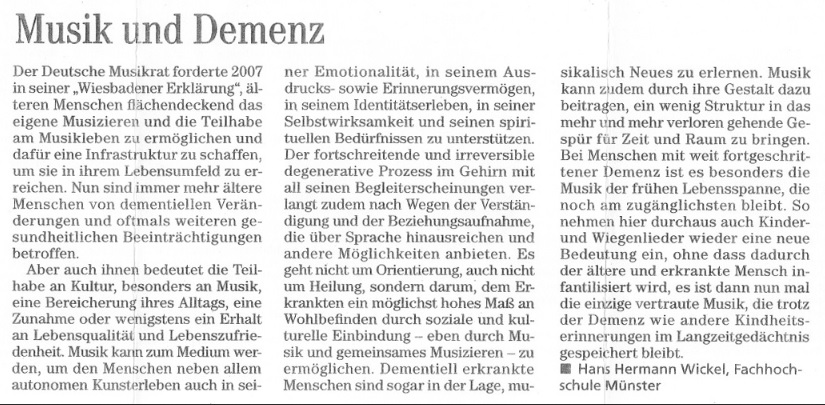
MUSIC AND BRAIN
The ability to make music is one of the most demanding performances of our central nervous system. Nearly all areas of the human brain are being activated during that process. Regular practice allows the interaction of the senses with the musculoskeletal system. This constitutes the basis for the control of an instrument.
Our entire nervous system consists of billions of neurons interconnected with each other, communicating through trillions of links with each other. The performances of the brain are based on structural as well as functional organization – which means how neurons are networked in the wiring diagram of the brain, how they work together and influence each other. In contrast to cells with other features, neurons are highly specialized nervous cells, which are by means of chemical and electrical processes capable of receiving, interpreting and forwarding environmental stimuli through receptors as information in the form of spikes. This information is received e.g. through light impulses or sound waves. Our brain is able to transform electrical impulses in conscious experience. One could say: our brain only transforms sound waves into music.
In contrast to most cell types, neurons cannot divide or proliferate. However, the neural progenitor cells have this capability. They are able to take over neural tasks. During that process new contacts are being linked with each other. This is how learning shapes the brains structure. The cells, which are being used, build stronger links, whereas the not demanded cells wither.
The functional and structural adaptation of the nervous system to special requirements is known as neuroplasticity. The tremendous versatility of the brain remains intact for a lifetime, which trials with adult piano beginners have verified. After only a 20-minute practice new nerve links can be proven in aspiring pianists: Cerebral areas for sensory perception and movement link in an intensified way. Playing the piano helps to practice coordination and concentration and develops an emotionally stimulating effect. Therefore we are not born with a finished neuronal network. Our brain has a huge potential for development. Take advantage of your “neurogenic Reserve“.
Text from Prof. Dr. Dr. rer. nat. Dieter Lütjohann; translated into English by Johannes Paqué

LITERATURE ABOUT MUSIC AND THE BRAIN:
- Gruhn, Wilfried: Der Musikverstand. Neurobiologische Grundlagen des musikalischen Denkens, Hörens und Lernens, Hildesheim [u.a.] 1998 (Olms-Forum).
- Hartogh, Theo/Wickel, Hans Hermann: Musizieren im Alter. Arbeitsfelder und Methoden, 2008 (Schott Verlag).
- Jäncke, Lutz: Macht Musik schlau? Neue Erkenntnisse aus den Neurowissenschaften und der kognitiven Psychologie von Lutz Jänicke, Bern 2008 (Huber Verlag).
- Sacks, Oliver W.: Der einarmige Pianist. Über Musik und das Gehirn, Reinbek bei Hamburg 32008 (Rowohlt Verlag).
- Spitzer, Manfred: Musik im Kopf. Hören, Musizieren, Verstehen und Erleben im neuronalen Netzwerk, Stuttgart [u.a.] 92009 (Schattauer Verlag).
- de Vree, Tom: Über das Üben. Ein Leitfaden für Schüler, Studenten und Lehrer, o.O. 1993 (Karthause-Schmülling Verlag).
- Havas, Kato: Lampenfieber. Ursachen und Überwindung unter besonderer Berücksichtigung des Violinspiels, Köln [u.a.] 1989 (Bosworth-Ed.).
- Jäncke, Lutz/Heuer, Herbert: Bewegungslernen, 1995 (Pabst-Verlag).
- Spahn, Claudia: Lampenfieber. Handbuch für den erfolgreichen Auftritt. Grundlagen, Analyse, Maßnahmen, 2012 (Henschel Verlag).
- Jourdain, Robert: Das wohltemperierte Gehirn. Wie Musik im Kopf entsteht und wirkt, Heidelberg [u.a.] 2001 (Spektrum Akad. Verl.).
- Krämer, Oliver: Strukturbilder, Sinnbilder, Weltbilder. Visualisierung als Hilfe beim Erleben und Verstehen von Musik, Augsburg 2011 (Wißner Verlag).